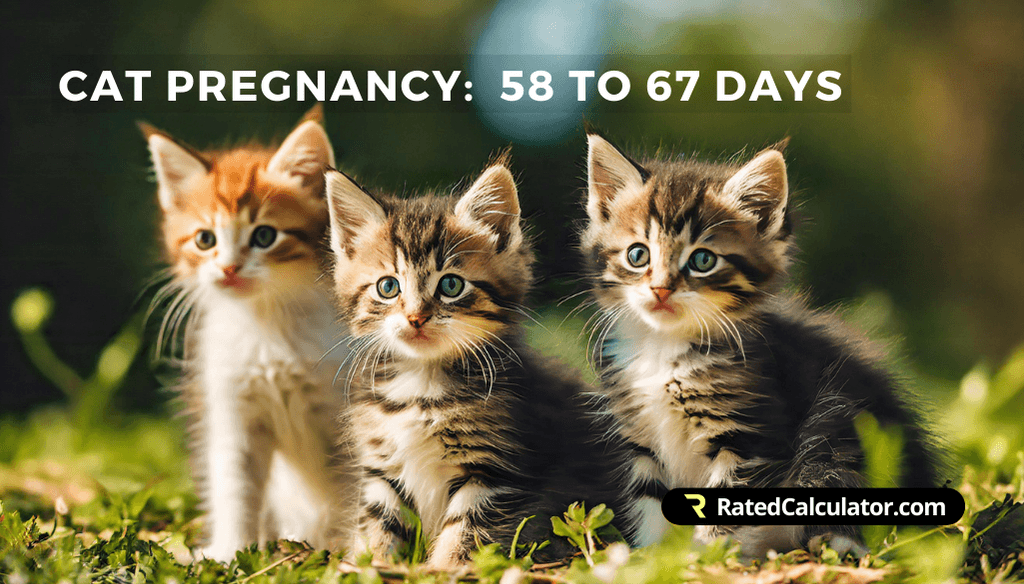Cat Pregnancy Calculator
| ‹ | August 2025 | › | ||||
|---|---|---|---|---|---|---|
| Su | Mo | Tu | We | Th | Fr | Sa |
| 27 | 28 | 29 | 30 | 31 | 1 | 2 |
| 3 | 4 | 5 | 6 | 7 | 8 | 9 |
| 10 | 11 | 12 | 13 | 14 | 15 | 16 |
| 17 | 18 | 19 | 20 | 21 | 22 | 23 |
| 24 | 25 | 26 | 27 | 28 | 29 | 30 |
| 31 | 1 | 2 | 3 | 4 | 5 | 6 |
Thursday, October 16, 2025
However, the due date could fall anywhere between 10 Oct and 19 Oct. Learn more about the Key Gestation Milestones.
Feline Gestation Milestones
Here's a detailed table describing the weekly milestones during a cat's pregnancy. Keep in mind that individual variations can occur, but this table provides a general guideline:
| Week | Dates | Milestones and Changes |
|---|---|---|
| Week 1 | 13 Aug to 20 Aug | Conception - Fertilization occurs. The queen (female cat) may have a slight increase in appetite. No visible physical changes. |
| Week 2 | 21 Aug to 27 Aug | Embryo Development - Embryos begin to form. The queen might show more affectionate behavior. Still, no significant physical changes. |
| Week 3 | 28 Aug to 3 Sep | Nidation - Implantation of embryos in the uterus. Nipples may start to become more pronounced and pinker - this is known as 'pinking up'. |
| Week 4 | 4 Sep to 10 Sep | Fetal Development - Fetal growth starts. The queen may begin to gain weight. A vet can typically confirm pregnancy through palpation around this time. |
| Week 5 | 11 Sep to 17 Sep | Visible Changes - The abdomen starts to swell. Increased appetite in the queen. It's possible to detect fetal movement upon careful palpation. |
| Week 6 | 18 Sep to 24 Sep | Rapid Growth - Fetal development is rapid. The queen's abdomen is noticeably larger. She might start nesting behaviors. |
| Week 7 | 25 Sep to 1 Oct | Preparation for Birth - The queen's nipples may enlarge as mammary glands develop. Nesting behavior becomes more pronounced. Decrease in physical activity. |
| Week 8 | 2 Oct to 8 Oct | Final Stage - The queen's abdomen is large and she may start to look for a birthing place. Decreased appetite and restlessness can be common. |
| Week 9 (up to Day 67) | 9 Oct to 16 Oct | Delivery Imminent - Look for signs of labor, such as restlessness, vocalizing, and possible loss of appetite. The queen may start labor within 24-48 hours when her body temperature drops. |
How Do You Calculate a Cat's Due Date?

To calculate a cat's due date, you can follow these steps:
- Determine the Date of Conception: This is the starting point for your calculation. If you know the exact date of mating, use that date. If not, use the earliest possible date of conception if there was a known mating period.
- Understand the Average Gestation Period: The average gestation period for cats is about 63 to 65 days, but it can range from 58 to 67 days.
Add the Gestation Period to the Conception Date: To calculate the due date, simply add 63 to 65 days to the date of conception. This will give you a rough estimate of when the cat might give birth.
For example, if the conception date is April 1st:
- Adding 63 days to April 1st gives you June 3rd.
- Adding 65 days to April 1st gives you June 5th.
So, the estimated due date would be between June 3rd and June 5th.
- Consider Variations: Remember that the due date is an estimate. Some cats may deliver a few days before or after the calculated due date.
Factors That Affect Cat Pregnancy Length
| Factor | Potential Impact on Pregnancy Length | Notes |
|---|---|---|
| Cat's Age | Young or very old cats may have slightly shorter or longer pregnancies. | First-time mothers and senior cats might experience variations. |
| Health & Nutrition | Poor health or nutrition can lead to prolonged or early labor. | Balanced diet and good health can promote a normal gestation period. |
| Breed Size | Generally, no significant impact, but larger breeds might have slightly longer pregnancies. | Most cat breeds have similar gestation periods. |
| Litter Size | Larger litters may lead to slightly earlier deliveries. | More kittens can mean less space and resources, prompting earlier birth. |
| Stress Levels | High stress can cause early labor. | A calm, safe environment is crucial for a full-term pregnancy. |
| Genetic Factors | Genetic makeup can subtly influence gestation length. | This is more individual to the cat and not well-documented. |
| Environmental Conditions | Poor environmental conditions can lead to early labor. | Comfortable living conditions are important for a healthy pregnancy. |
| Medical Conditions | Certain health issues can lead to premature or delayed labor. | Conditions like feline diabetes or hypertension might affect pregnancy length. |
It's important to understand that these factors can have varying degrees of impact, and not all will necessarily result in a significant change in gestation length. Monitoring and veterinary care are crucial to ensure a healthy pregnancy for your cat.
Cat Pregnancy Reference Table
Below is a reference table showing the due date for all days of the year.